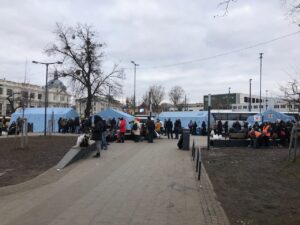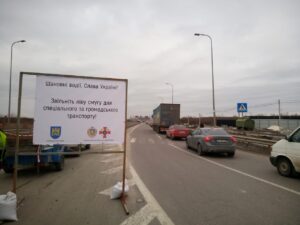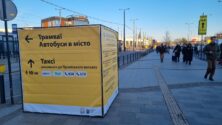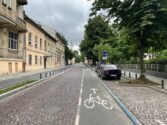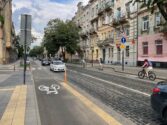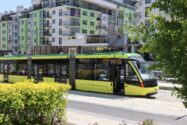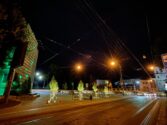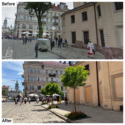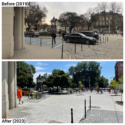July 19, 2023
Mobility in Times of Crisis: A View from Lviv, Ukraine
The City of Lviv was selected as an Honorable Mention of the 2021 Sustainable Transport Award for their efforts to promote public transport, walking, and cycling. Read the MOBILIZE case study.
ITDP’s own history as Bikes Not Bombs is rooted in a belief in the right to basic mobility, especially during crises.
Positioned in western Ukraine, the City of Lviv is home to over 700,000 people and has spent the past several decades working to reclaim its streets from cars and congestion to ensure a more sustainable, people-oriented city. Lviv’s work on revitalizing its public transit systems, expanding its bike infrastructure, and pedestrianizing public spaces earned it an honorable mention in the 2021 STA program. Public advocacy, together with political will, helped to institutionalize sustainable transport priorities and policies, resulting in new City departments, plans, and projects that helped the city respond to the pandemic in 2020.
Since early 2021, however, the City of Lviv and Ukraine as a whole has faced another major crisis on the heels of the pandemic — Russia’s invasion of the country and an ongoing war on-the-ground. As the world grapples with the conflict and its geo-political impacts, in Lviv, we can see firsthand the important role that reliable and accessible transport infrastructure plays in helping people adapt and survive in such volatile circumstances.
This piece below was authored by Orest Oleskiv, Head of the Transport Office of the City of Lviv, to provide a local perspective on the city’s evolving mobility challenges.
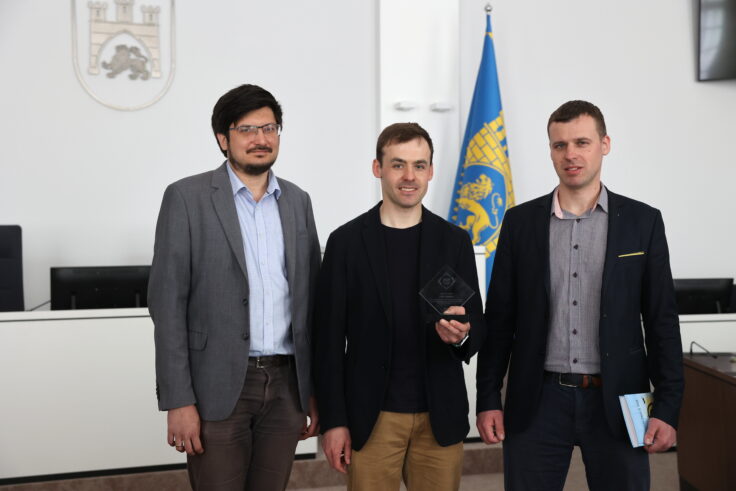
After February 22, 2022, life in Ukraine turned into a ‘before and after’. Ukraine suffered a full-scale invasion by the Russian Federation. As the City of Lviv is located in the west of Ukraine, it has perhaps been impacted less in comparison to the other large cities of the country. Nevertheless, this past June of 2023, the city experienced two significant attacks — one in which a Russian missile struck a residential housing complex, killing ten civilians and injuring forty. From the first day of the invasion, Lviv was transformed into one of the main humanitarian and logistics hubs for the rest of the country, serving as a main artery, road, and railway connection with the European Union (EU) to the west.
In the first two months of the invasion, Lviv’s main train station received millions of people who arrived on evacuation trains, escaping the primary war-zone territories to the east. The city’s newly reconstructed Dvirtseva Square, situated in front of the main railway station, served as a landing point to handle the enormous influx of people transferring to trains and buses to Poland and for those searching for shelter in the more secure western regions.
Fortunately, the redevelopment of the Square included improved and expanded pedestrian and public space, allowing it to better accommodate essential services such as volunteer information points and 24/7 heating and food installations. Private vehicles were also not allowed access to the Square to prevent additional congestion and hazardous conditions. Special pedestrian routes and areas were then developed and installed to help guide people to services and information around the transport hub. As the war progresses into another year, a big challenge for Lviv continues to be in maintaining reliable public transport service that allows residents and frontline workers to move around safely and quickly.
The fuel and energy crisis that resulted from attacks on the country’s reserves and a blockade of Ukrainian seaports directly impacted access to fuel for our transport. City officials were able to work with transport companies to obtain a limited supply for bus carriers that still relied on it — nevertheless, bus services still had to be reduced by nearly 25 percent. These impacts are a reminder of the perpetual challenges that come with relying heavily on fossil fuels in our sector.
This drastic reduction in conventional bus usage did, however, lead the City to increase the frequency of tram and trolleybus routes. The overall efficiency of these electric transport systems also improved as vehicle congestion on streets decreased. Nevertheless, in the winter of 2022, Lviv was hit with another big hurdle as Russia initiated missile attacks on the area’s energy grid and electricity infrastructure. This resulted in a number of power blackouts, forcing the City to cut back on its use of electric transport so as not to overload the grid. As a result, Lviv had to return to operating its conventional, fuel-based bus routes to continue providing transport under ever-changing conditions.
Some areas of hope and progress have begun to emerge recently. Since April 2023, the volatility with transport service and fuel access has somewhat stabilized, allowing the City room to focus on improving and maintaining its most critical transit connections. For example, in June, Lviv began to introduce cashless payment systems on some bus routes, with the aim of having it fully implemented by the end of the year. While most transport-related repairs and maintenance projects were halted in early 2022, the City has also been able to complete redesigns for three major streets based on plans that began in 2021.
The design and redevelopment of key streets and spaces demonstrate Lviv’s commitment to creating a people-oriented city, now more than ever. The design plans utilize many principles that were included in Lviv’s 2018 Sustainable Urban Mobility Plan, such as providing equal street space to active mobility, creating more public space, and enhancing road safety measures. Now, despite the extraordinary circumstances, Lviv is in a surprising moment to significantly reshape and enhance its streetscapes for the first time in nearly two decades.
Now, under the extension of martial law in Ukraine, cities are not allowed to undertake any more major projects for street and road renovations. As a result, the City of Lviv is concentrating on implementing more low-cost, flexible measures to improve safety and accessibility. We are continuing to develop our cycling network by creating emergency lanes and narrowing the existing car lanes — nearly 10 new lanes will be implemented by year’s end. The City has also placed a large focus on on-street parking management, with paid parking policies introduced on 48 streets. The number of parking wardens for enforcement have also doubled up to eighty. This focus is helping officials make on-street parking around the city center more organized, helping to ensure clear, reliable access to the city.
As Lviv is not able to undertake any large infrastructure projects for the time being, the City is continuing to develop and assess its Sustainable Urban Mobility Plan to create priorities and strategies for future investment and action. For now, the City has created two key documents that are headed for the City Council’s approval — one is a 10-year cycling plan that sets the goals for the development of cycling networks, and the second is an electric mobility policy that sets goals for the oversight of electric public transport, bikes, and cars. We can only hope that when the conflict is finally stabilized, we can continue implementing the many elements of this Plan that have been so unfortunately halted.
It is important that cities and decision-makers recognize the role of accessible, resilient, and reliable transport systems in safeguarding people’s basic mobility — before, during, and after times of crisis.
Learn more about Lviv’s transport strategies in this 2021 STA webinar:



